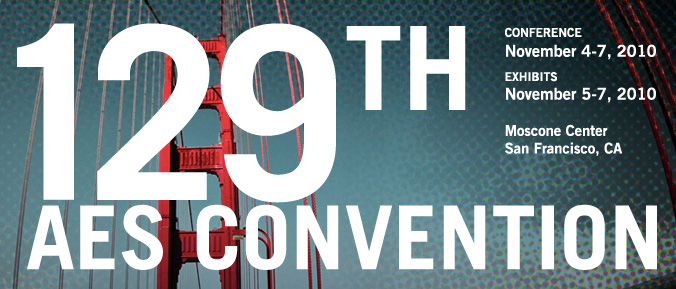
AES San Francisco 2010
Paper Session P1
P1 - Transducers and Processing for Live Sound
Thursday, November 4, 9:30 am — 12:30 pm (Room 220)
Chair:
Scott Norcross
P1-1 A Performance Ranking of Seven Different Types of Loudspeaker Line Arrays—D. B. (Don) Keele, Jr., DBK Associates and Labs - Bloomington, IN, USA
Seven types of loudspeaker line arrays were ranked considering eight performance parameters including (1) beamwidth uniformity, (2) directivity uniformity, (3) sound field uniformity, (4) side lobe suppression, (5) uniformity of polar response, (6) smoothness of off-axis frequency response, (7) sound pressure rolloff versus distance, and (8) near-far polar pattern uniformity. Line arrays analyzed include: (1) un-shaded straight-line array, (2) Hann-shaded straight-line array, (3) “J”-line array, (4) spiral- or progressive-line array, (5) un-shaded circular-arc array, (6) CBT circular-arc array, and (7) a CBT delay-curved straight-line array. All arrays were analyzed assuming no extra drive signal processing other than frequency-independent shading. A weighted performance analysis yielded the following ranking from best to worse 6, 7, 5, 4, 3, 2, 1, with the CBT Legendre-shaded circular-arc array on top and the un-shaded straight-line array on the bottom.
Convention Paper 8155 (Purchase now)
P1-2 A Reliable Procedure for Polarity Measurements on Line Arrays—Gregor Schmidle, Markus Becker, NTi Audio AG - Schaan, Liechtenstein
The performance of a line array strongly depends on the correct installation of its loudspeakers. For instance, a single loudspeaker with incorrect polarity may clearly compromise the sound level and directivity of the whole system. The identification of such errors, however, can be very time consuming. Therefore, it is desirable to have a fast, yet reliable procedure to finding such array elements. This paper presents a step-by-step method to check the integrity of a line array and to find the cause in case of a polarity problem. Besides the theoretical background, a successful practical case is described.
Convention Paper 8156 (Purchase now)
P1-3 Calculating Time Delays of Multiple Active Sources in Live Sound—Alice Clifford, Josh Reiss, Queen Mary University of London - London, UK
Delays caused by differences in distance between sources and microphones cause many problems in live audio, most notably comb filtering. This paper presents a new method that is able to calculate the relative time delays of multiple active sources to multiple microphones where previous methods are unable to. The calculated time delays can be used to compensate for delays that cause comb filtering and can also be used in source separation methods that utilize delays. The proposed method is shown to be able to calculate delays in configurations where other methods fail and is also able to give an estimate of sources physical positions. The results show that multiple delays can be accurately calculated when multiple sources are active and that noise can effect the accuracy of the method.
Convention Paper 8157 (Purchase now)
P1-4 Coherent Superposition of Acoustic Sources as a Function of Environmental Parameters—Stefan Feistel, Ahnert Feistel Media Group - Berlin, Germany; Rainer Feistel, Institut für Ostseeforschung - Warnemuende Germany
Sound reinforcement systems and loudspeaker arrays consist of numerous, spatially distributed sources. The signal alignment of these components is crucial to provide even level coverage and consistent spectral distribution throughout the audience areas. One usually assumes that sources located close to each other sum coherently in contrast to sources spaced far apart which sum energetically at the receiver. However, in reality this assumption seldom holds since environmental conditions, such as fluctuations of temperature and air flow and their spatial correlation, determine the actual level of coherence. We derive the theoretical framework for this important effect based on stochastic theory. We quantify the resulting coherence as a function of the different environmental parameters. Results are verified using numerical models and measurement.
Convention Paper 8158 (Purchase now)
P1-5 Optimizing the Controls of Homogeneous Loudspeaker Array—Michael Terrell, Mark Sandler, Queen Mary University of London - London, UK
An optimization technique is demonstrated that can be used to control the frequency response at multiple receiver locations to a homogenous loudspeaker array. Each loudspeaker element in the array is identical but can be controlled individually using vertical and horizontal angle, delay, broadband gain, a 7-band parametric equalizer, and a 5th order all pass filter. The arrays examined contain 8 loudspeakers, and the controls are optimized using a genetic algorithm. This is demonstrated for a 2-D case study based on the requirement that the magnitude response at each location is the same.
Convention Paper 8159 (Purchase now)
P1-6 Perceptual Dimensions of Stage-Floor Vibration Experienced During a Musical Performance—Clemeth L. Abercrombie, Artec Consultants Inc. - New York, NY, USA; Jonas Braasch, Rensselaer Polytechnic Institute - Troy, NY, USA
The human ability to distinguish differences in tactile signals generated by a musical instrument and experienced on typical stage-floor constructions is explored using an audio-tactile display (headphones and calibrated motion platform). Audio and vibration signals generated by a contrabass are combined with mechanical impedance measurements of five stage floors to create stimuli. Test participants are asked to report differences between tactile signals given a fixed audio environment. Multidimensional scaling is used to identify perceptual dimensions in subjective responses. Results show that stage vibration exceeds the threshold of perception, with acceleration up to 0.04 ms-2 Wk-peak. Sensation level dominates perceived differences between tactile signals measured for different stage-floor constructions, while audio-tactile time delays have negligible influence.
Convention Paper 8160 (Purchase now)
